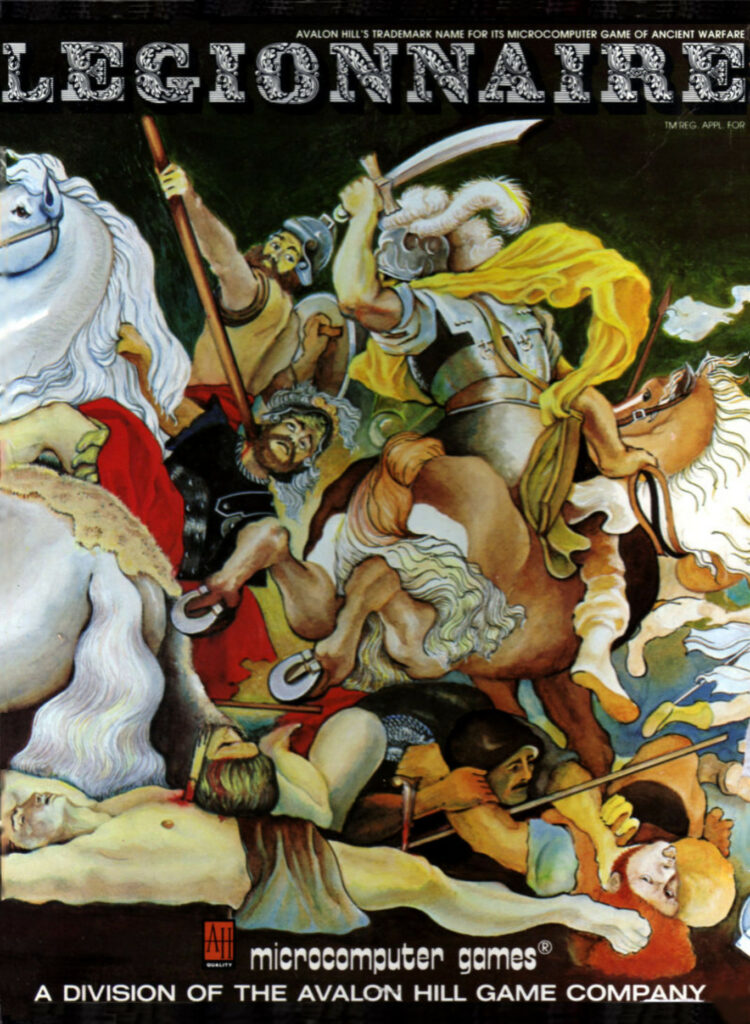
Centurio Monocerōs – I don’t understand your concern. Gauls are ferocious yes, but disorganized. Easy to crush once you resist their first charge!
It may be so in other games, Proconsul. But in Legionnaire, they are all choke-full of magic potion !
What ? All of them ? Not just the small blonde one and the fat red-haired one ?
All of them, Proconsul !

Chris Crawford’s Legionnaire is the last of the fall 1982 Avalon Hill release, and the one Avalon Hill expected the most from. Crawford’s Tanktics had sold in the high thousands of units – a massive success for 1981 – and of course Crawford had released the even more successful Eastern Front. For this reason, when Avalon Hill announced the release of 6 new computer games in the September 1982 issue of its magazine The General, five games are described in one line each, and then Legionnaire gets special consideration : “Legionnaire is the sixth, and possibly the best, game from Avalon Hill. A real-time simulation of tactical combat during the days of Caesar, it is the design and programming of Chris Crawford – a gentleman as recognizable to Atari computer owners as Don Greenwood is to wargamers.”
Crawford’s 1982 Legionnaire is the much-upgraded version of a Legionnaire he had released in 1979. The 1982 iteration comes with strong arguments : it is one of the first “real-time tactics” games, and certainly the first with any degree of visual quality. As such, it is also sometimes described as a precursor to real-time strategy, but as I will show Legionnaire has much more in common with the battle part of a Total War than with an Age of Empires.
The game starts by asking me how many legions I want to command – I choose eight. The barbarians will be twice that number, half infantry, half cavalry. I also get to choose what types of barbarians I will confront – each of the 16 types having their own characteristics. I pick Senones infantry and Nervii cavalry.


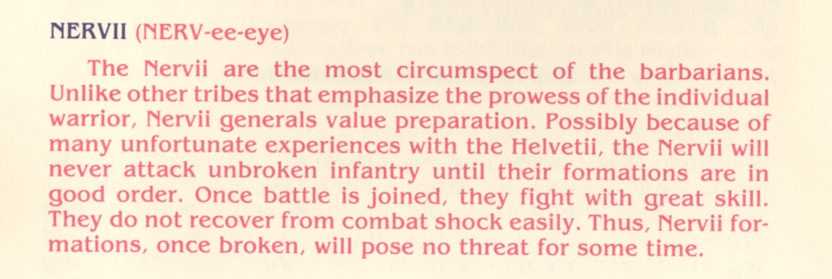
And with that, my armies and the barbarians are placed by the computer on the map.
My forces (2 cavalry and 6 infantry legions, including Caesar’s powerful 10th legion) have some sort of hills next to them – a safe place to anchor my defence.
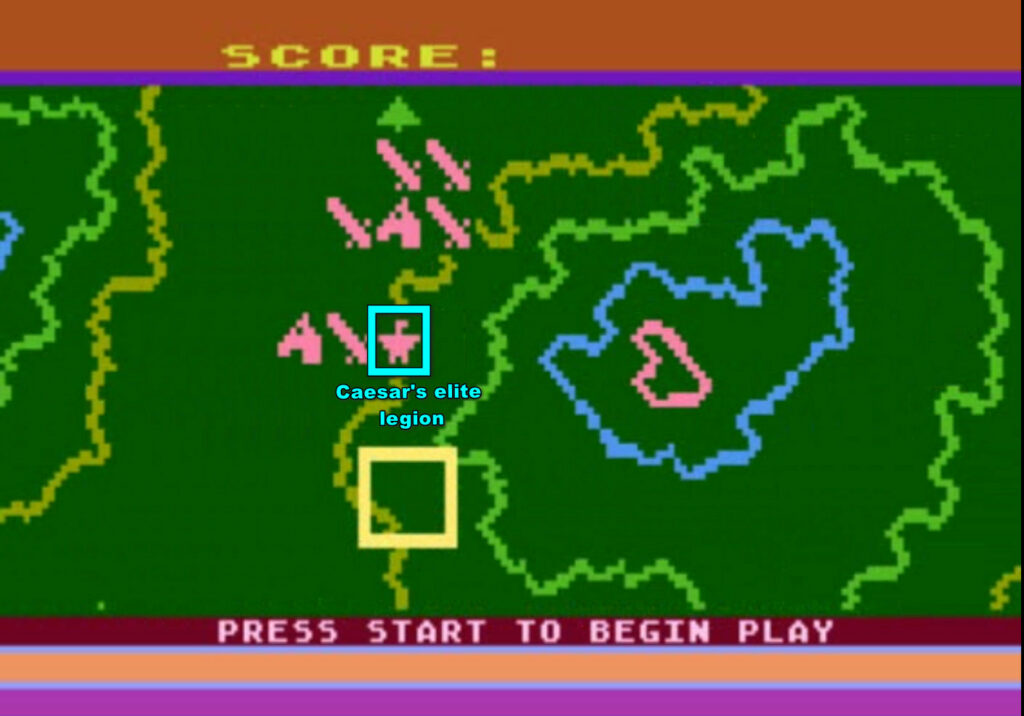
The problem is that the barbarians are deployed on the other side of this hill, and both tribes are very close to each other. In general, I like to defeat the barbarians one group after the other but in this situation, the two groups are going to be able to regroup so defeat in detail is not an option. I immediately order my troops to take position on the top of the hill.

My forces are on the move. Caesar’s elite legion arrives on the top very shortly before the barbarians ! It should be able to hold it long enough for the rest of the Romans to arrive, especially as I deployed the cavalry for support.
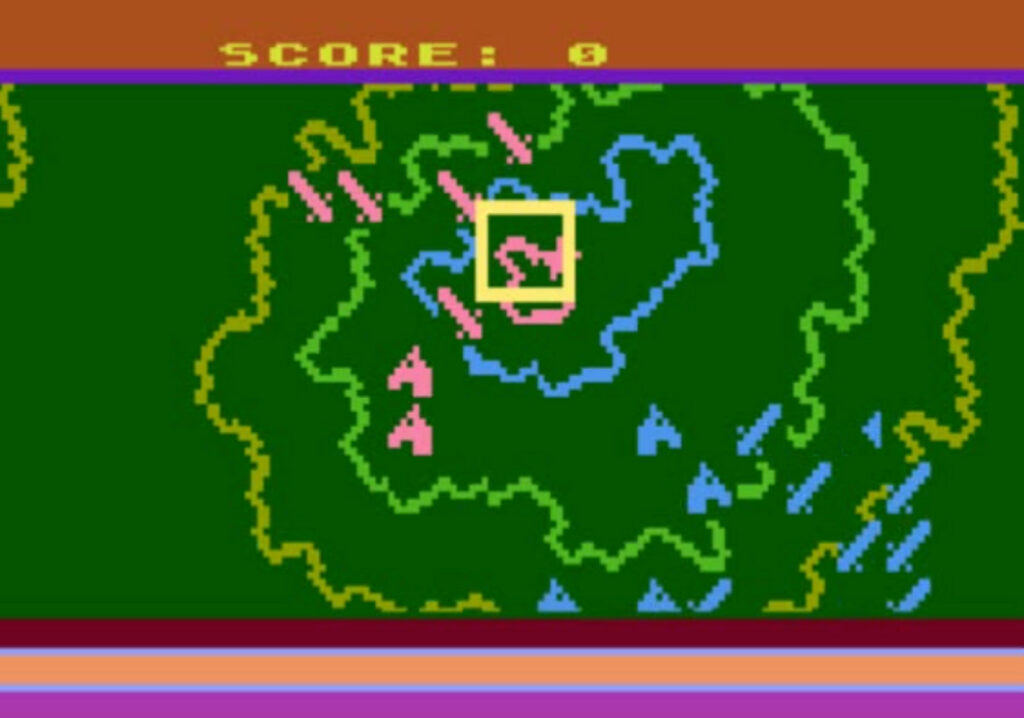
The Nervii calvary tries to dislodge Caesar and his men. The battle rages on against the barbarian cavalry while the Senones infantry is rushing to support its allies.

In the chaos of the battle, some of the Roman cavalry is isolated from the rest of the legions :
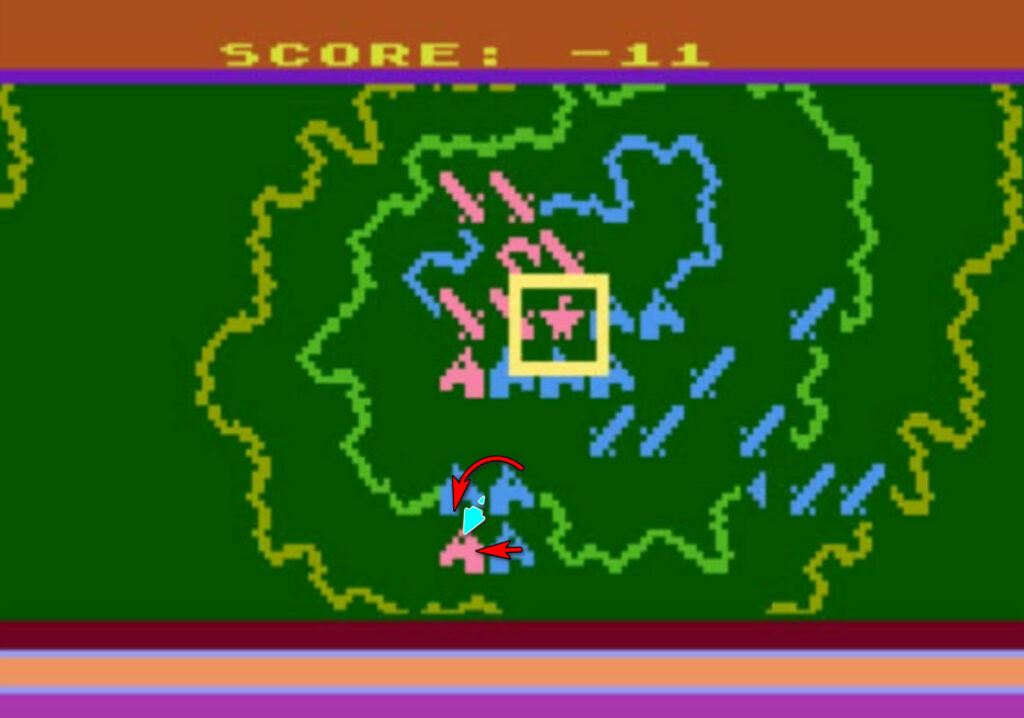
Surrounded, it is easily destroyed, and the barbarians try to flank the Roman position :
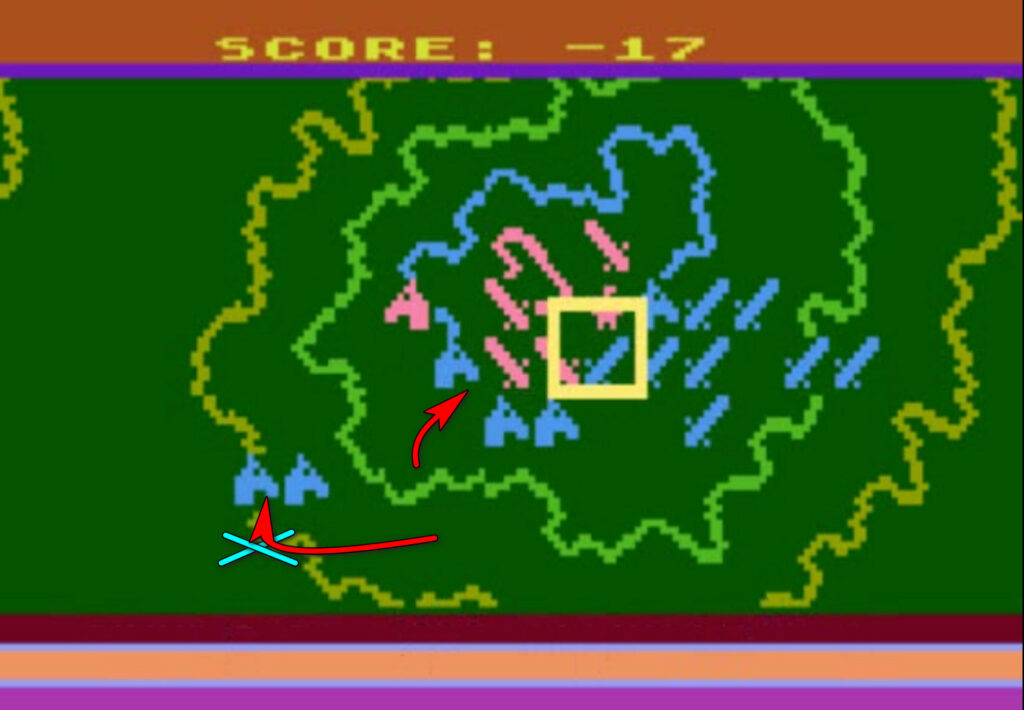
The other cavalry unit is also badly depleted : it started the battle with 1800 men and horses. After its delaying action against the barbarians, it is now down to less than 300 !

The only way for this unit to still be useful is to attract the enemy cavalry away from the rest of my force, while I defend as well as possible against the winded Senones infantry which reached the top of the hill !

It works for a time, but eventually, the rest of the cavalry are caught back, and destroyed. The pursuers then come straight for the back of my line, and this time they don’t attack from downhill !
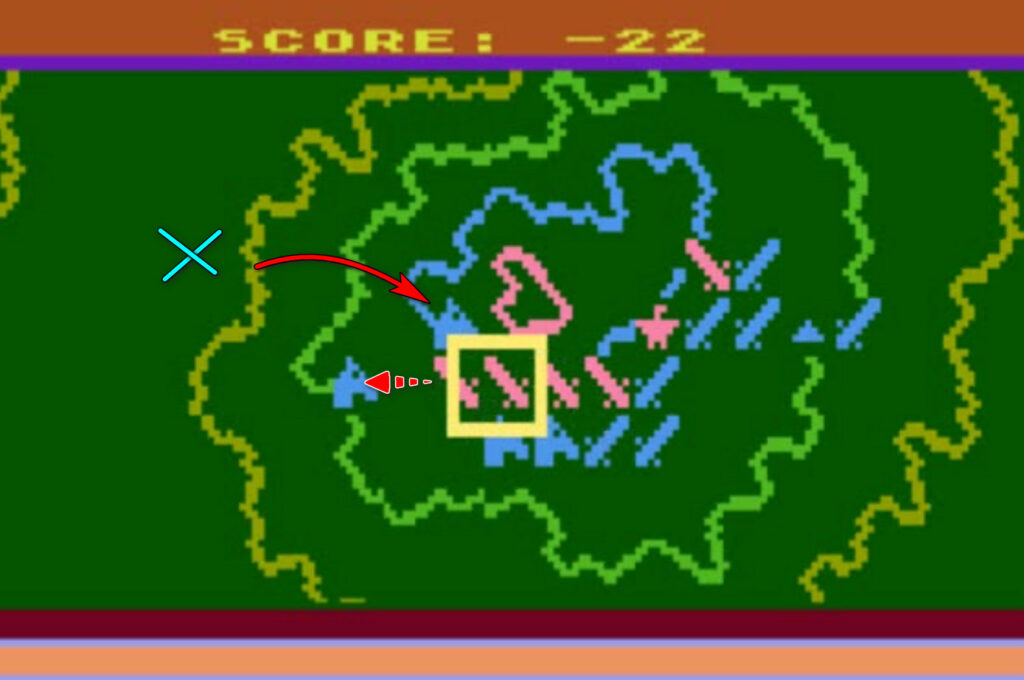
One of my legions is pushed from the North, isolated and shortly thereafter, destroyed !
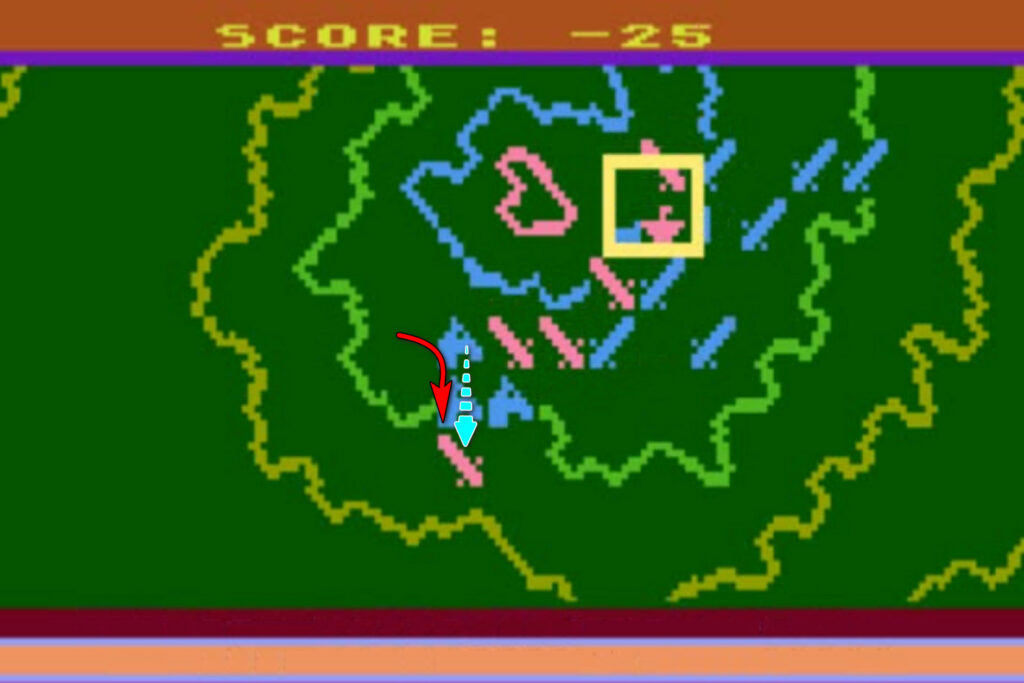
It is the end, some of my legions are destroyed, others are routed all over the place, and pursued by what’s left of the Nervii cavalry :

Three depleted legions are now fighting against a barbarian horde that surrounds them …
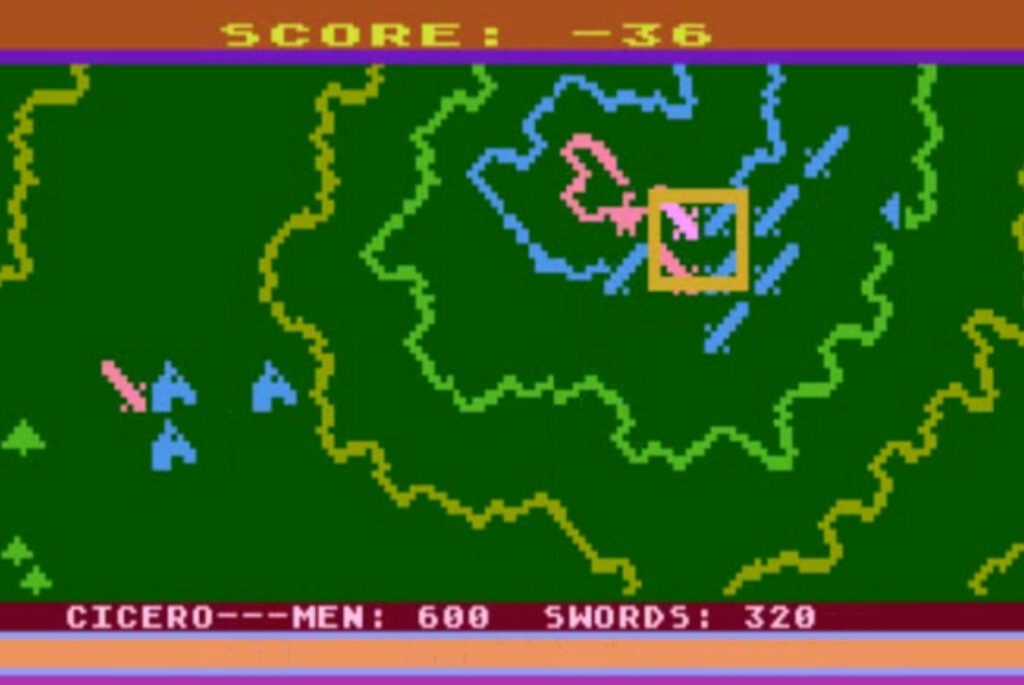
And finally, Caesar collapses with the remains of the 10th legion, which disappears from the map !

Once again, the Gauls are triumphant against the Romans ! The Roman Republic is in dire straights ! After the loss of such a promising General as Julius Caesar it may last only a few years before the barbarian hordes topple it down !
Rating and Reviews

Legionnaire by Chris Crawford, published by Avalon Hill, USA
First release : August 1982 on Atari for the “modern” version
Tested on : Atari emulator
Total Hours Tested : 6 hours
Average duration of a battle : 15 minutes
Complexity : 1/5 (the game is not complex – it is very hard though)
Would recommend to a modern player : No
Would recommend to a designer : No
Final Rating: Flawed and obsolete
1981 had been an enormous year for Chris Crawford : Atari released his nuclear power plant simulator SCRAM somewhere in the first half of the year, APX released Eastern Front 1941 in August and Avalon Hill rereleased his first game Tanktics at the end of the year. Mid-1981 already, he pondered what he would do next, and dusted off a game he had released two years prior in 1979 on Commodore PET : Legionnaire.
I already mentioned Legionnaire (1979) when I covered Centurion(1981), the authorized clone by Robert Zdybel. Legionnaire (1979) was an unsatisfactory game according to Crawford himself, but it is also probably the first real-time tactics computer game. It is also lost – only around 100 copies were sold – so our only indication on its gameplay comes from Centurion, various notes or comments from Crawford (in particular in his book “On Game Design” – the basis for most of this article) and Zdybel.

Being clones, Legionnaire (1979) and Centurion share a lot of features :
- The map is one screen large, with an hexagonal grid ; dark hexagons marking impassable terrain, though there were only very few of them in Legionnaire),
- All units (8 in Legionnaire 1979 and 10 in Centurion) were represented by numbers,
- Commands were given by using the numpad to select a unit and then directions,
- Both games had only two unit statistics : maximum strength and effective strength – the same system that was used in Eastern Front 1941, and that Crawford claims he took from the tabletop wargame Thirty Years War by SPI. As Crawford states, “all through the 1980s […] a small group of old-time board wargamers have made a disproportionate contribution to the evolution of game design, largely because of all the good ideas they stole from other fields of game design.“,
- Legionnaire 1979 had morale for the barbarians, which Centurion removed to avoid having to pursue the last escaping barbarian across the map,
- On the other hand, Legionnaire 1979 had an icon to indicate units that had received orders and were moving, which was absent from Centurion,
- Finally, Legionnaire 1979 seems to have had only infantry and cavalry (I am not 100% sure), Centurion added bowmen and pikemen.
Legionnaire may have been only two years old, but it was already antiquated by 1981 standards. The game needed more than a refresher, it needed a new vision.
As early as June 1981, Crawford wrote some specs for the future Legionnaire, but he got stuck on some design features. An important development came by circumstances: during a wargame conference in the Bay Area, Crawford casually mentioned his modernization effort to the CEO of Avalon Hill, Eric Dott, stating he planned to release the game on APX. But Crawford had forgotten that his contract with Avalon Hill included his two earlier games : Tanktics and Legionnaire. Eric Dott had not forgotten and informed Crawford that if Legionnaire was to be built around a new vision, he had a shopping list. This shopping list included in particular one item : “the scrolling map technology that made Eastern Front 1941 so appealing“.

Crawford was still stuck on various design problems. To quote him “I couldn’t seem to pull the design together; my design notes from those days express much vacillation and pessimism about the design.” Stuck, Crawford slept on the project until December.
Back at the design table, Crawford realized that adding map scrolling had impacts that clarified the design. In particular, it forced Crawford to make sure that as much action as possible happened on one screen. This meant fewer units for the player to manage (initially 10 for each side, later Crawford doubled the number of barbarians for balance, but allowed players to choose how many units they would command and fight), no Roman encampments and Barbarians definitely not scattered about. The design was not yet the final one, but he had more than enough to start working, finishing a beta on the 1st of March and sending the final version to Avalon Hill on the 31st of May.
A. Immersion
Let’s start with the most obvious : Legionnaire is a beautiful game for 1982. Of course, it is far from modern standards, but unlike so many games of the early 80s, the art does not get in the way. In addition, it is the first game I played so far where I did not have to turn off the sound. Interestingly, Crawford used the sound to dampen the problem of not seeing all your units at the same time : if one of your units is fighting, wherever it is, you will hear the battle sound effects.
Crawford also tried to give more character to the units in the game by giving a name and a special behaviour to each individual legion, and by allowing you to choose your enemies among 16 different Barbarian tribes, each with their own strengths and weaknesses. These specificities were not supposed to be historical, but at least they would mirror different possible behaviours on the battlefield.
Alas, despite all those efforts, the game does not feel very immersive ; I don’t really feel I am fighting with Roman legions – the game is quite simply too generic for that.
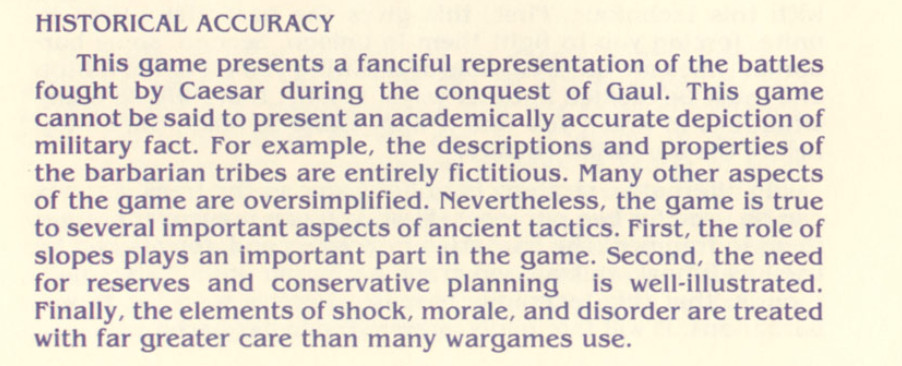
Rating : Poor
B. UI , Clarity of rules and outcomes
The game uses the same type of controls as Eastern Front 1941. Unfortunately, as Crawford himself felt, it is not because it worked well in a turn-based game that it would work well in a different, real-time game:
- Giving orders to units takes time as you need to move the pointer from unit to unit, and then drag-and-drop the pointer slowly to their targets. If you are not in full defense (which is boring !) your units tend to spread out as even your infantry units have different speeds !
- It is not uncommon for units to be spread across different screens, and there is no way to scroll fast as you would in modern games with a mouse and a mini-map,
- There is the problem, already present in Centurion, that by the time you give an order to a unit this order is already obsolete : the target has moved, or the situation has evolved. It is even worse than in Centurion, as it is faster to select a unit with the keyboard than with the joystick !
Such control problems are understandable given the limits of 1982 technology, but there are some other issues that are related to applying an incorrect ruleset given the technology available. In Legionnaire, you cannot quickly check the status of your units : whether a unit has 2000 soldiers left or 200, it looks exactly the same. Checking the individual status of each of them takes time, and you cannot even anticipate properly because the rules for damage are explained nowhere in the manual so while you know that Legions will usually prevail in 1-to-1 combat against a barbarian unit, you don’t know by which margin because each of your 10 units is different in quality. Worse : for a game in which morale is so central, you have no idea whether a unit is about to rout, or even actually routing (as opposed to just moving). When you know, it is too late already !
It is a problem that Bunten had solved elegantly in Cytron Masters: units don’t have HP and don’t have morale, except bunkers that you visually see depleting over time.
In general, the game is a mess, once the swords are locked in the player pretty much loses control over what is happening.
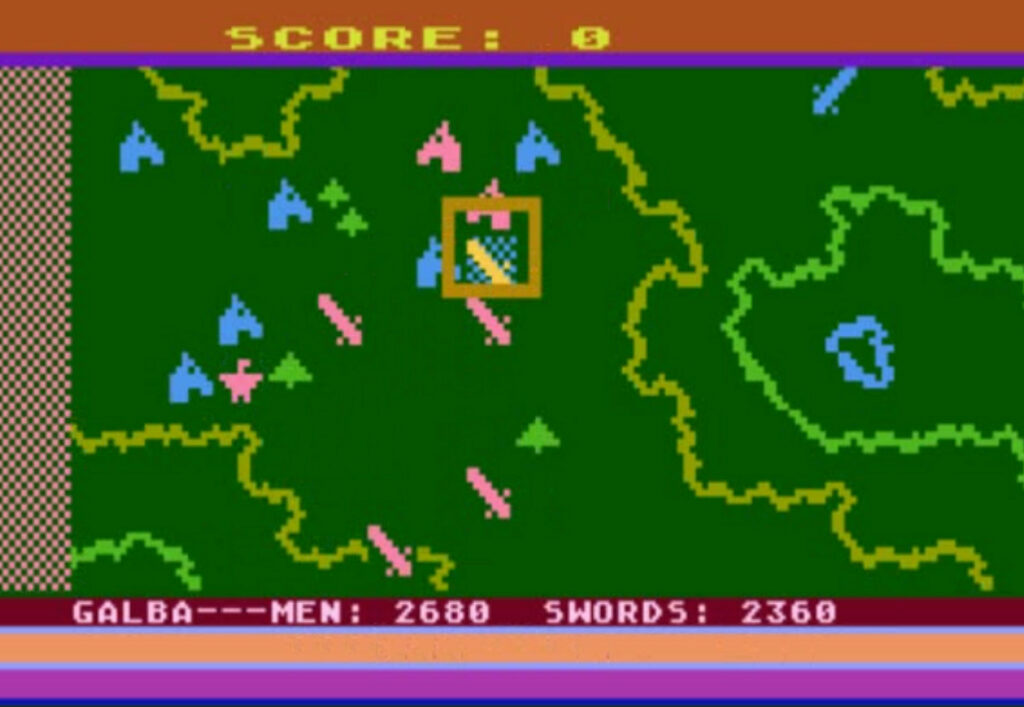
Rating : Very poor
C. Systems
Sadly the manual explains very little about combat resolution, except that :
- Units are weaker when fighting against an enemy uphill,
- Units are weaker when attacked on the flanks or from the back (which only “exists” when the unit is marching or attacking in one direction – a unit not moving faces no direction).
The latter is a problem, because it stops you from manoeuvring close to the enemy, lest you immediately offer a flank to the treacherous Gauls. Realistic ? Certainly. But not fun ! Once the melee starts there is very little you can do that will not make your situation worse.
The game also has a morale system : even with acceptable effective strength, some units can panic and retreat. It is a good idea in theory, but once one of your units start to run, there is almost nothing you can do as it will be followed, reattacked, and routed again. In theory, you are supposed to keep a force in reserve to save the routed units. In practice, it almost never works as your reserve will not be able to catch up to the panicking soldiers and their pursuers, except if you were in a defensive line allowing you to immediately use your reserve to plug the hole.
Combined, those rules limit the possible tactics to only one against most barbarians : on the top of a hill, in a defensive line, waiting for the enemy.
Rating : Very poor
D. Scenario design & Balancing
The game allows you to choose your scenarios, by picking how many legions you want to command and what tribes you are fighting. The game is harder the more legions you control : not only do you have more information to process, but each individual legion is weaker than the previous one, and the last legion you can have is all but useless.
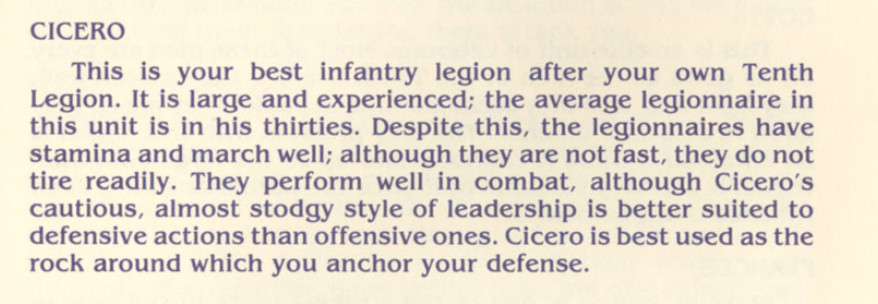

You really feel the difference in quality and in speed between the best and the worst legions, though putative differences in offensive/defensive skills (or between the two cavalry units) were not obvious to me.
Similarly, each barbarian tribe is different, not only in combat capacity but also in the way they move on the map (eg as a bloc vs dispersed). Legionnaire includes “tutorial barbarians”, the Auscii (“if the Auscii give you problems, perhaps you had better go back to PAC-MAN” quips Crawford) and an end boss : the Huns themselves, though of course, Crawford reminds the player that they only swept through Europe 400 years after Caesar.
Sadly, while you usually try to take into account the capabilities of each legion in your tactics, you cannot really exploit the peculiarities of the barbarians : there is too much advantage in being in defense and battles are usually not quick enough to hope to destroy one group before the other arrives, except in those rare cases where you were lucky with the barbarian initial deployment.
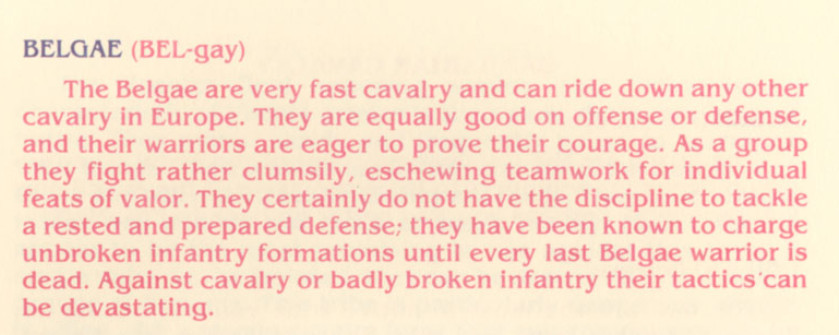

Finally, I am mixed about the map : It is huge, but you will always fight on a small part of it anyway, usually on top of a hill.
Rating : Acceptable
E. Did I make interesting decisions
No. I make a few positioning decisions, but those are not really interesting.
F. Final rating
Flawed and obsolete. Initially impressed by the reputation of the game, I wanted to give it a well-designed and obsolete, but then I realized that there are very few things well-designed in Legionnaire. Worse, I did not have fun at all, as the game is ruined by huge game design and UI flaws.
The game is certainly a technical prowess and if you wanted a real-time historical wargame in 1982 Legionnaire was almost the only game you could buy. But unlike turn-based games, whose designers could leverage the experience of tabletop games, Legionnaire had no good practice to build upon. It suffered from all the flaws expected from a precursor. Hundreds if not thousands of games did real-time tactics since then, making the flaws of Legionnaire all the more apparent for a modern gamer. Still, if I must compare the “real-time tactics/strategy” precursors, Cytron Masters is by far the superior game. In my opinion, Bunten identified the design and UI constraints of real-time games better than Crawford did.
Contemporary Reviews
I keep reading current (and not so current) retrospectives that stated that Legionnaire initially received mixed reviews, but reading the contemporary reviews I can testify Legionnaire was initially saluted with unanimous praise, with only minor quips on its UI here and there. For instance, Bill Willet from Computer Gaming World (November 1982) writes a long article concluding by : I consider Legionnaire to be as challenging as Eastern Front and immensely more playable […] Legionnaire and Eastern Front are breaking ground.” And then the wishlist :” I hope Chris takes the Legionnaire format, expands the map, adds random terrain generation, moves it into the gunpowder era, and adds a two-player option.”
Other very positive reviews include :
- Softline (March 1983),
- Byte Magazine (March 1983),
- Compute! (July 1983),
- Creative Computing (December 1983)
All of them insist on how easier and faster to play Legionnaire is compared to Eastern Front, Compute! even stating that it could please the arcade aficionados. Legionnaire is even covered by the non-gaming InfoWorld (February 1983), which complains about the UI but insists on the technological leap it represents (“it advances computer game complexity to a new level of real-time interaction“). The Book of Atari Software in 1983 gives straight As to Legionnaire, a performance only replicated by Eastern Front and Zork.
The first dissonant voice (outside of France, where Tilt gives Legionnaire a solid but not perfect 4 stars out of 6 in March 1984) is Jerry Pournelle writing for Byte Magazine in May 1984. Pournelle did not like the game at all. As part of an extremely long rambling about, well, I am not sure but it is titled “Chaos Manor’s hard-Disk System” and subtitled “Dirty filters, 8/16-land, views of the future and inevitably more“, he allocates a one-page tangent on Legionnaire where he remarks“I hated [Legionnaire]. It appears to be a game of strategy, but it takes place in real-time, which means in practice it’s an arcade game masquerading as a game of strategy”. After complaining about pretty much everything he concludes: “Legionnaire has neither history nor realism nor playability to recommend it.” After which he feels compelled to say that his son Philip played the game a lot. Much later, Computer Gaming World in its retrospective on wargames (October 1990) calls it a “marginal historical simulation of Roman tactics.” In any case, the game did not sell very well, despite being released on multiple platforms including Commodore 64 and Apple II.
The fairest review of them all may be the one by Chris Crawford himself in On Game Design : “Neither the original version nor the Avalon Hill version of Legionnaire was a great game. Like all of my games, it had a great many clever ideas, but clever ideas don’t ensure great designs. The games were certainly competently designed and executed : nobody had any complaints. […] Both games played rather like a thinking man’s arcade game. I’m not ashamed of the overall results […] but there was no lightning bolt of genius in the design : I never felt any passion for it. Every creative person must grind out a great many works, some of which will be turkeys, some of which will be merely competent, and a few of which will be masterpieces. Legionnaire was no turkey, but it was certainly no masterpiece.” He added in the margin of his book : “if you’re not passionate about it, the best you can achieve is competence.“